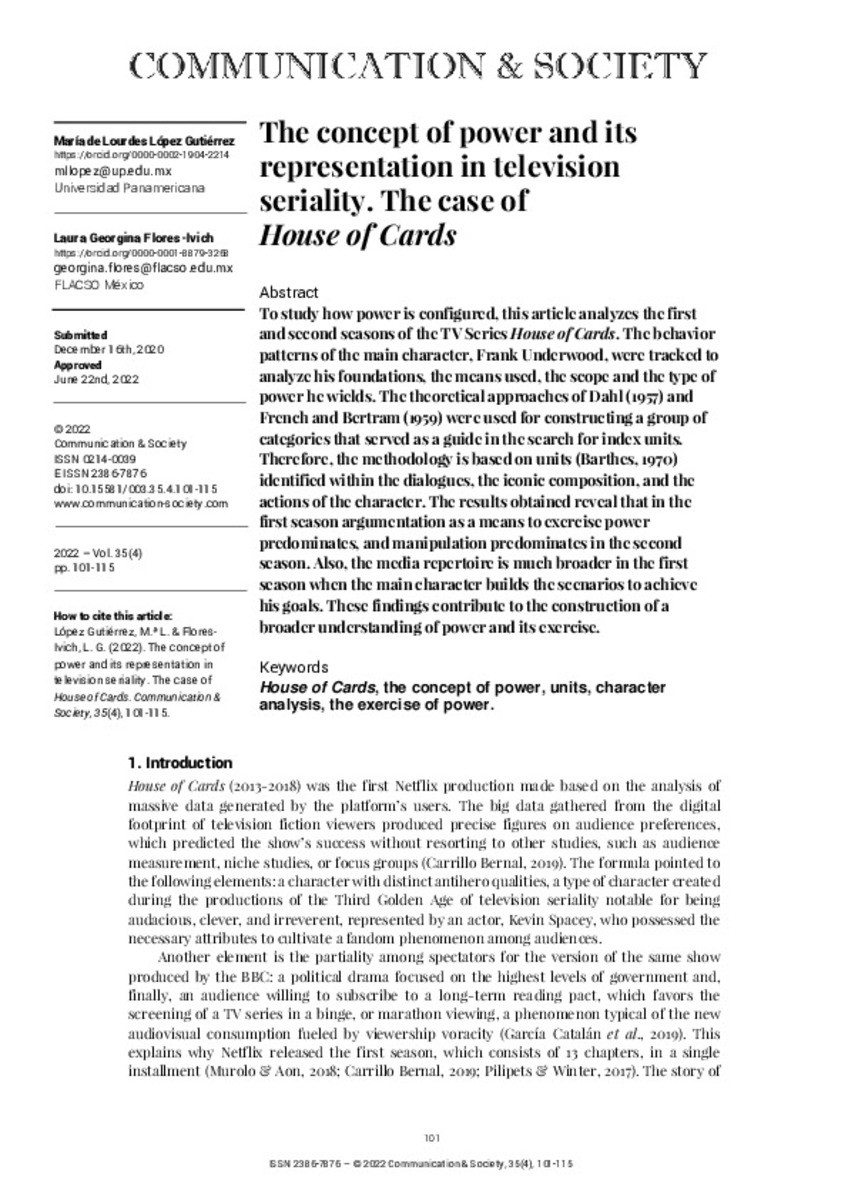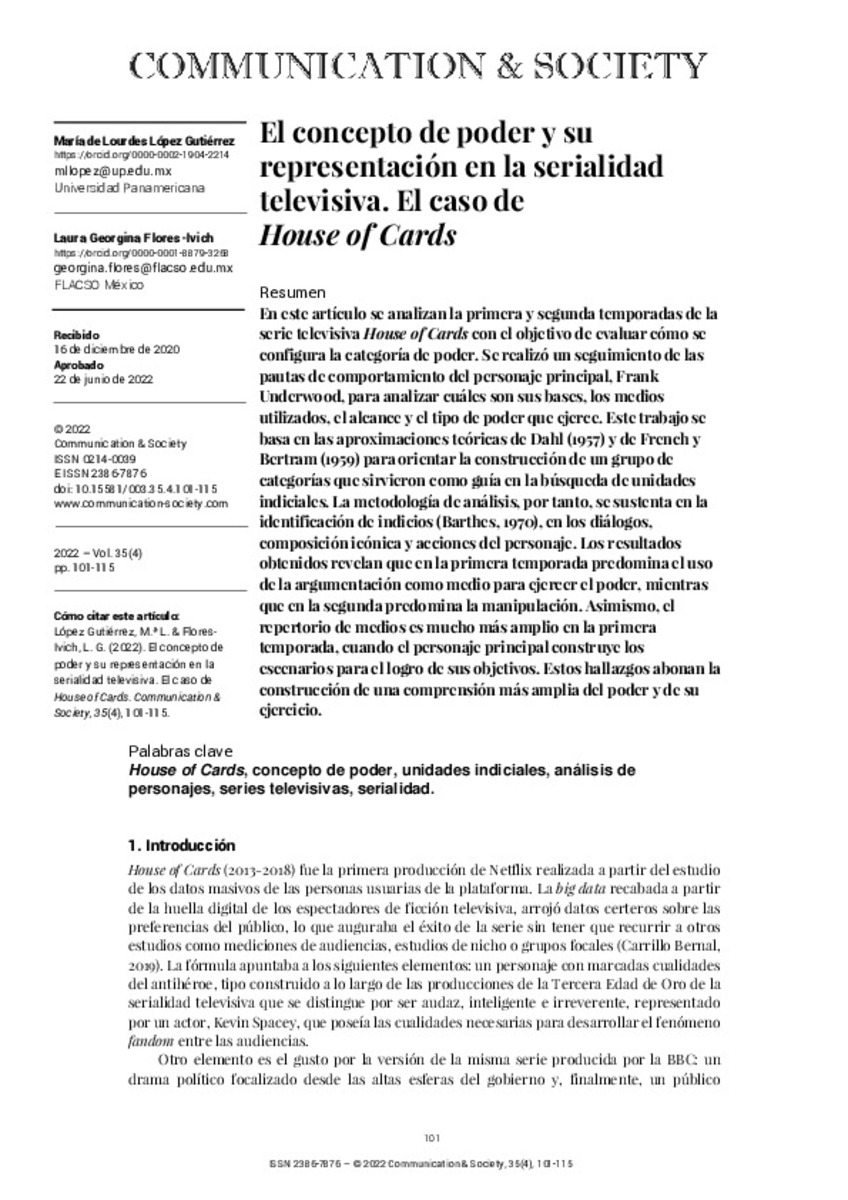Full metadata record
| DC Field | Value | Language |
|---|---|---|
| dc.creator | López-Gutiérrez, M.L. (María de Lourdes) | - |
| dc.creator | Flores-Ivich, L.G. (Laura Georgina) | - |
| dc.date.accessioned | 2022-10-03 | - |
| dc.date.accessioned | 2022-12-20T14:57:38Z | - |
| dc.date.available | 2022-12-20T14:57:38Z | - |
| dc.date.issued | 2022 | - |
| dc.identifier.citation | López-Gutiérrez, M.L. (María de Lourdes); Flores-Ivich, L.G. (Laura Georgina). "The concept of power and its representation in television seriality. The case of «House of Cards»". Communication & Society. 35 (4), 2022, 101 - 115 | es |
| dc.identifier.issn | 2386-7876 | - |
| dc.identifier.uri | https://hdl.handle.net/10171/64911 | - |
| dc.description.abstract | To study how power is configured, this article analyzes the first and second seasons of the TV Series <em>House of Cards</em>. The behavior patterns of the main character, Frank Underwood, were tracked to analyze his foundations, the means used, the scope and the type of power he wields. The theoretical approaches of Dahl (1957) and French and Bertram (1959) were used for constructing a group of categories that served as a guide in the search for index units. Therefore, the methodology is based on units (Barthes, 1970) identified within the dialogues, the iconic composition, and the actions of the character. The results obtained reveal that in the first season argumentation as a means to exercise power predominates, and manipulation predominates in the second season. Also, the media repertoire is much broader in the first season when the main character builds the scenarios to achieve his goals. These findings contribute to the construction of a broader understanding of power and its exercise. | en_US |
| dc.description.abstract | En este artículo se analizan la primera y segunda temporadas de la serie televisiva <em>House of Cards</em> con el objetivo de evaluar cómo se configura la categoría de poder. Se realizó un seguimiento de las pautas de comportamiento del personaje principal, Frank Underwood, para analizar cuáles son sus bases, los medios utilizados, el alcance y el tipo de poder que ejerce. Este trabajo se basa en las aproximaciones teóricas de Dahl (1957) y de French y Bertram (1959) para orientar la construcción de un grupo de categorías que sirvieron como guía en la búsqueda de unidades indiciales. La metodología de análisis, por tanto, se sustenta en la identificación de indicios (Barthes, 1970), en los diálogos, composición icónica y acciones del personaje. Los resultados obtenidos revelan que en la primera temporada predomina el uso de la argumentación como medio para ejercer el poder, mientras que en la segunda predomina la manipulación. Asimismo, el repertorio de medios es mucho más amplio en la primera temporada, cuando el personaje principal construye los escenarios para el logro de sus objetivos. Estos hallazgos abonan la construcción de una comprensión más amplia del poder y de su ejercicio. | es_ES |
| dc.language.iso | eng | - |
| dc.publisher | Servicio de Publicaciones de la Universidad de Navarra | es_ES |
| dc.rights | info:eu-repo/semantics/openAccess | es_ES |
| dc.subject | House of Cards | - |
| dc.subject | Concepto de poder | - |
| dc.subject | unidades indiciales | - |
| dc.subject | análisis de personajes | - |
| dc.subject | series televisivas | - |
| dc.subject | serialidad | - |
| dc.title | The concept of power and its representation in television seriality. The case of «House of Cards» | en_US |
| dc.type | info:eu-repo/semantics/article | es_ES |
| dc.identifier.doi | 10.15581/003.35.4.101-115 | - |
| dadun.citation.endingPage | 115 | - |
| dadun.citation.number | 4 | - |
| dadun.citation.publicationName | Communication & Society | - |
| dadun.citation.startingPage | 101 | - |
| dadun.citation.volume | 35 | - |
Statistics and impact
Items in Dadun are protected by copyright, with all rights reserved, unless otherwise indicated.







